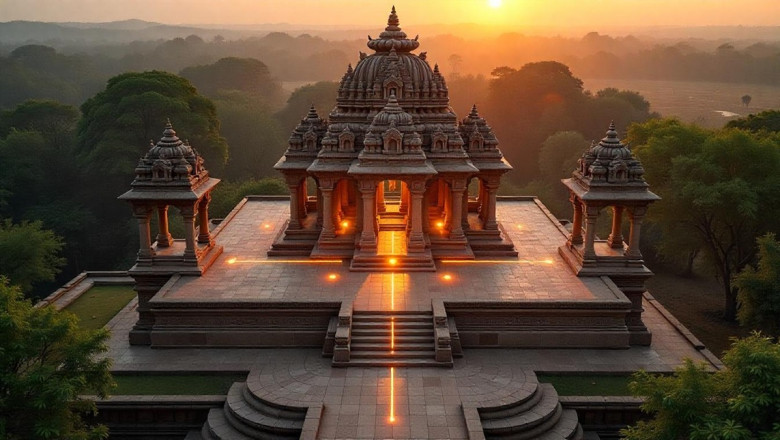views
Indian temples are not merely places of worship but also marvels of ancient architectural wisdom and spiritual symbolism. Rooted deeply in tradition, their construction reflects an intricate blend of Vastu Shastra, Vedic astrology, and cultural ethos, all coming together to create spaces that resonate with divine energy and harmony.
The Essence of Indian Temples and Vastu Shastra
Across India, temples stand as majestic testaments to religious devotion, artistic brilliance, and scientific knowledge that dates back thousands of years. But beyond their aesthetic grandeur, the architectural design of Indian temples follows strict principles derived from Vastu Shastra — the ancient Indian science of architecture and spatial arrangement.
Vastu Shastra is a holistic framework that guides the orientation, layout, and proportions of buildings, ensuring that they align with natural forces such as the sun, wind, earth, and cosmic energy. In the context of Indian temples, temple vastu shastra aims to create a sacred space that fosters spiritual upliftment, mental peace, and prosperity for devotees.
The Role of Vedic Astrology in Temple Design
While Vastu Shastra governs the physical aspects of construction, Vedic astrology—another profound ancient science—plays a crucial role in timing and aligning temple activities. Astrology helps select auspicious dates for groundbreaking ceremonies, installations of idols, and various rituals.
Moreover, Vedic astrology influences the symbolism embedded in temple architecture, such as the placement of deities and sacred motifs, which are believed to correspond to celestial bodies and planetary energies. This combined application of Vastu Shastra and Vedic astrology ensures that temples act as conduits for cosmic harmony and spiritual energy flow.
Understanding the 7 Horse Vastu in Temple Architecture
One of the lesser-known but fascinating concepts in temple Vastu is the 7 horse Vastu or running horse Vastu. This refers to the symbolic representation of seven horses, which often appears in temple carvings, sculptures, and layout designs. The motif of seven horses holds deep significance in Indian mythology and Vastu principles.
The number seven is sacred in Hinduism, symbolizing completeness and perfection—mirroring the seven chakras, seven colors of the rainbow, and seven musical notes. The image of horses running, often seen as pulling the sun chariot of Surya (the Sun God), represents energy, progress, and the unstoppable force of life.
In temple Vastu, the running horse vastu signifies the dynamic flow of positive energy. Temples designed with this concept integrate pathways, pillars, or motifs that mimic the motion of horses, channeling vitality and cosmic rhythm within the sacred space. This design is believed to enhance the spiritual experience of devotees, providing mental clarity, strength, and prosperity.
Practical Applications of Temple Vastu Shastra
Modern architects and spiritual planners often study ancient Indian temples to incorporate temple Vastu Shastra principles into contemporary religious and residential structures. The objective is to replicate the harmony achieved in historic temples, balancing elements such as:
- Directional alignment: Temples are typically oriented to face east or north-east, welcoming the rising sun’s energy.
- Proportional symmetry: Maintaining balance in height, width, and spatial distribution helps stabilize energy flow.
- Placement of sanctum sanctorum: The innermost chamber where the deity resides is carefully located to harness maximum spiritual power.
- Use of natural materials: Stone and wood are preferred for their grounding qualities and ability to sustain positive vibrations.
Incorporating elements like the 7 horse vastu within layouts or decorative schemes reinforces vitality and spiritual momentum, bridging ancient wisdom with modern aspirations.
The Spiritual and Cultural Legacy of Indian Temples
Indian temples remain timeless icons of spirituality and culture. Their design transcends mere functionality, aiming instead to create sanctuaries that inspire devotion, peace, and cosmic balance. The intertwining of Vastu Shastra and Vedic astrology is a testament to the holistic worldview of ancient Indian civilization, which sought to harmonize human existence with the universe’s rhythm.
From the grand temples of South India to the intricate shrines of the North, the principles of temple Vastu Shastra continue to guide artisans and priests. The 7 horse Vastu motif serves as a subtle yet powerful reminder of movement, energy, and divine grace, making these temples living embodiments of ancient wisdom.
Conclusion
The ancient sciences of Vastu Shastra and Vedic astrology underpin the majestic beauty and spiritual efficacy of Indian temples. Concepts like the 7 horse vastu and running horse vastu highlight how symbolic imagery and architectural design converge to foster a harmonious environment that elevates the human spirit.
As India’s rich cultural heritage evolves, the reverence for temple architecture and the ancient principles behind it endures. Whether through restoring historic sites or designing new spiritual spaces, the fusion of temple Vastu Shastra with Vedic astrology continues to offer profound insights into living in tune with nature and the cosmos.






















Comments
0 comment